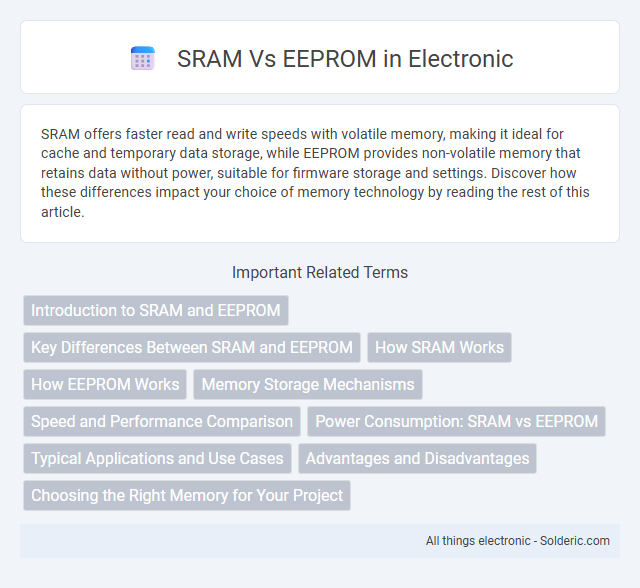SRAM offers faster read and write speeds with volatile memory, making it ideal for cache and temporary data storage, while EEPROM provides non-volatile memory that retains data without power, suitable for firmware storage and settings. Discover how these differences impact your choice of memory technology by reading the rest of this article.
Comparison Table
| Feature | SRAM | EEPROM |
|---|---|---|
| Full Name | Static Random Access Memory | Electrically Erasable Programmable Read-Only Memory |
| Data Retention | Volatile (data lost when power off) | Non-volatile (data retained without power) |
| Write Speed | Very fast (nanoseconds) | Slow (milliseconds) |
| Read Speed | Very fast | Moderate |
| Power Consumption | Low, but continuous power needed | Low in standby, higher during write |
| Write Endurance | Unlimited | Limited (10^5 to 10^6 cycles) |
| Typical Usage | CPU cache, registers, high-speed buffers | Firmware storage, configuration data, small data logs |
| Cost per Bit | Higher | Lower |
| Cell Structure | 6-transistor latch | Floating gate transistor |
Introduction to SRAM and EEPROM
SRAM (Static Random-Access Memory) is a type of volatile memory that stores data using bistable latching circuitry, enabling fast access times without requiring periodic refresh cycles. EEPROM (Electrically Erasable Programmable Read-Only Memory) is a non-volatile memory that retains data even when power is removed, allowing electrical erasure and reprogramming of individual bytes. Both SRAM and EEPROM play critical roles in embedded systems, with SRAM prioritized for speed and EEPROM for persistent data storage.
Key Differences Between SRAM and EEPROM
SRAM (Static Random-Access Memory) offers fast, volatile data storage used for temporary memory tasks, while EEPROM (Electrically Erasable Programmable Read-Only Memory) provides non-volatile storage that retains data without power. SRAM consumes more power but allows quicker read/write cycles, whereas EEPROM supports slower write speeds but enables data to be electrically erased and reprogrammed multiple times. Your choice depends on whether speed or data persistence is the priority in your application.
How SRAM Works
SRAM (Static Random-Access Memory) operates by using bistable flip-flop circuits made of transistors to store each bit of data, maintaining information as long as power is supplied. Unlike EEPROM, SRAM does not require periodic refreshing, offering faster access times and lower latency for your computing needs. This volatile memory is ideal for cache and register storage due to its speed and efficiency in real-time data handling.
How EEPROM Works
EEPROM (Electrically Erasable Programmable Read-Only Memory) stores data by trapping electrons in a floating gate transistor, allowing information to be rewritten and retained without power. Unlike SRAM, which relies on flip-flop circuits needing constant power to maintain data, EEPROM enables long-term non-volatile storage with slower write cycles but higher data retention. The erase and write processes involve applying specific voltage pulses to alter the charge on the floating gate, enabling selective byte-level programming and erasure.
Memory Storage Mechanisms
SRAM stores data using bistable latching circuitry, enabling fast and volatile memory access without the need for periodic refreshing. EEPROM retains information through charge storage in floating-gate transistors, allowing non-volatile memory that preserves data without power. Your choice between SRAM and EEPROM depends on whether speed or persistent data retention is more critical for your application.
Speed and Performance Comparison
SRAM offers significantly faster read and write speeds compared to EEPROM, making it ideal for applications requiring rapid data access and temporary storage. EEPROM, while slower due to its non-volatile nature and byte-level write cycles, is primarily used for persistent data storage where speed is less critical. The performance gap stems from SRAM's volatile memory design using flip-flops, allowing nanosecond access times versus EEPROM's slower flash memory technology with millisecond write times.
Power Consumption: SRAM vs EEPROM
SRAM (Static Random-Access Memory) consumes more power than EEPROM (Electrically Erasable Programmable Read-Only Memory) during active operation due to continuous power requirements for data retention. EEPROM exhibits significantly lower power consumption in standby mode because it does not need constant power to maintain stored data. Optimizing embedded system design involves balancing SRAM's higher power draw with EEPROM's slower write speeds and limited write cycles.
Typical Applications and Use Cases
SRAM is commonly used in CPU cache, embedded systems, and high-speed buffers due to its fast access times and volatile nature, making it ideal for temporary data storage during processing. EEPROM is suited for non-volatile storage applications such as firmware storage, configuration settings, and small amounts of user data that require infrequent updates. Your choice depends on whether speed or data retention without power is the priority in your specific application.
Advantages and Disadvantages
SRAM offers fast access speeds and low power consumption, making it ideal for cache memory and temporary data storage, but it is volatile and loses data when power is off. EEPROM provides non-volatile storage, retaining data without power, which suits firmware and small data updates, though it has slower write speeds and limited write cycles. Your choice depends on whether speed or data retention is more critical for the application.
Choosing the Right Memory for Your Project
SRAM offers fast access speed and low latency, making it ideal for applications requiring quick data retrieval and frequent read/write cycles. EEPROM, with its non-volatile nature, is better suited for storing configuration settings and data that must persist without power. Selecting the right memory depends on balancing speed, volatility, and endurance requirements specific to your project's needs.
SRAM vs EEPROM Infographic

 solderic.com
solderic.com